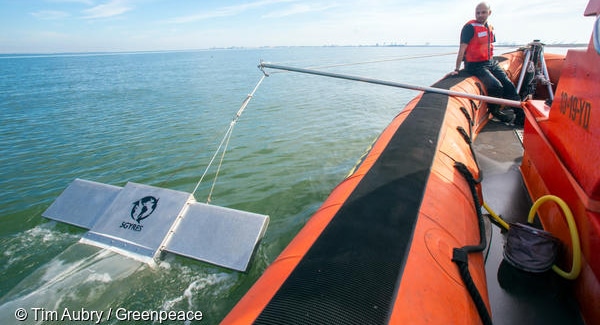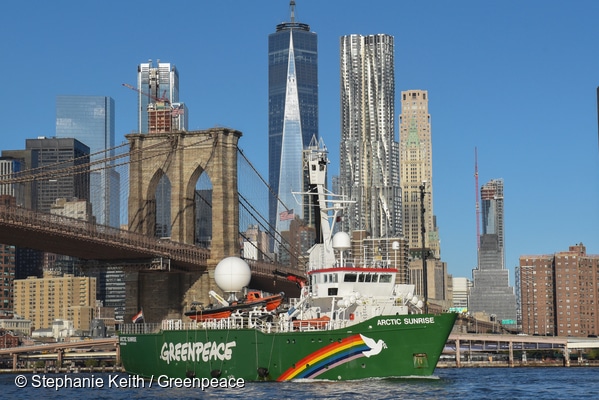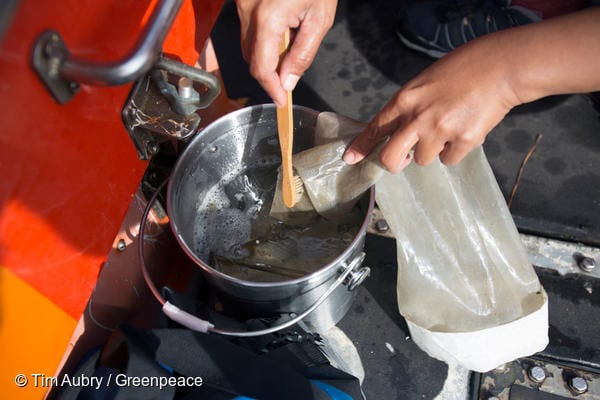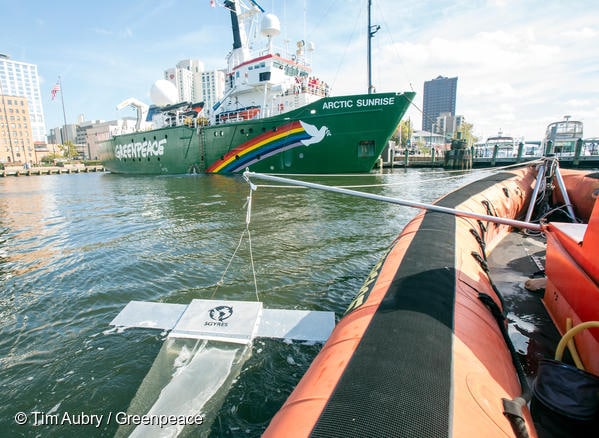Marine Life & Conservation
Greenpeace and 5 Gyres find microplastics in every U.S. East and West Coast sample collected

 Over the past year, Greenpeace collected microplastic data as part of 5 Gyres’ TrawlShare program while its ship the Arctic Sunrise travelled down the East and West Coasts. The TrawlShare program engages partners and community scientists globally to collect data on ocean plastics, which will contribute to an update of 5 Gyres’ 2014 global estimate. Utilizing a manta trawl net, the organization sampled 13 locations along the East Coast, 17 locations on the West Coast, and six locations on its Atlantic crossing from Amsterdam to New York City. Varying quantities of microplastics were found in every single sample collected, whether in the middle of the ocean or closer to shore.
Over the past year, Greenpeace collected microplastic data as part of 5 Gyres’ TrawlShare program while its ship the Arctic Sunrise travelled down the East and West Coasts. The TrawlShare program engages partners and community scientists globally to collect data on ocean plastics, which will contribute to an update of 5 Gyres’ 2014 global estimate. Utilizing a manta trawl net, the organization sampled 13 locations along the East Coast, 17 locations on the West Coast, and six locations on its Atlantic crossing from Amsterdam to New York City. Varying quantities of microplastics were found in every single sample collected, whether in the middle of the ocean or closer to shore.
Greenpeace travelled to the North Pacific Gyre, which has become known as the Great Pacific Garbage Patch, in late September to continue its microplastic data collection. The organization will document the quantity and types of microplastics present, work to identify the sectors or corporations responsible for the plastic pollution, and capture extensive photo and video footage of the gyre. Greenpeace is working to dispel the notion that we can simply clean up the plastics in the ocean, instead calling on corporations to reduce their single-use plastic footprints.
“We have found microplastics on the East Coast, the West Coast, and in the middle of the ocean,” said Greenpeace Plastics Campaigner Kate Melges. “We travelled to Antarctic waters, and found plastics there. Researchers have even found plastics in the deepest point of the ocean, the Mariana Trench. No matter how far we are from land, we are seeing the impact of corporations’ addiction to plastics. It’s time for businesses and governments to phase out single-use plastics for good.”
Between its East and West coast ship tours, Greenpeace also travelled to the Antarctic and conducted microplastic samples in the region using 5 Gyres’ trawling net. Microplastics and microfibers were even found in the remote Antarctic waters. Greenpeace was conducting scientific research, including landmark submarine dives to little-known Antarctic seabed ecosystems, as part of a campaign to create an Antarctic Ocean Sanctuary.
On the East Coast in late 2017, Greenpeace collected microplastics data along the Hudson River and New York Harbor in NY, at the Elizabeth River in Norfolk, VA and off the coast of Wilmington, NC and Miami, FL. On the West Coast in 2018, Greenpeace collected microplastics in the Pacific Ocean near Port Angeles, WA, Portland, OR, San Francisco, CA, Long Beach, CA, and San Diego, CA. The organization also conducted sampling further out to sea on its transits between the ports. Greenpeace found the highest concentrations of microplastics near Brooklyn on the East Coast and near Long Beach on the West Coast. Higher quantities of microplastics were found in samples collected closer to land.
“Our TrawlShare program was designed to grow our global microplastics dataset that is now focusing on areas closer to land,” said Carolynn Box, 5 Gyres Science Programs Director. “It was clear that we needed more data in bays and near shore environments to use as evidence to support policies limiting single-use plastics and requiring better product design. Greenpeace has collected an impressive number of microplastic samples that support the growing trend that microplastics are everywhere – a plastic smog in the world’s oceans.”
As part of its TrawlShare program, 5 Gyres provides trawls and protocols for community scientists to collect data on marine plastic pollution, raise awareness about this important issue, and contribute to a more robust global dataset. In 2014, 5 Gyres published the first global estimate on plastic pollution in the world’s oceans. The data from Greenpeace and other community scientists will be used to update the Global Estimate of Marine Plastic Pollution, planned for release in early 2019.
For more information please visit the Greenpeace website by clicking here.
Blogs
The Ocean Cleanup Breaks 10,000,000 KG Barrier

The Ocean Cleanup, the global non-profit project, has removed a verified all-time total of ten million kilograms (22 million lbs.) of trash from oceans and rivers around the world – approximately the same weight as the Eiffel Tower.
To complete its mission of ridding the oceans of plastic, The Ocean Cleanup uses a dual strategy: cleaning up the Great Pacific Garbage Patch (GPGP) to remove the plastic already afloat in the oceans, while stopping the flow of plastic from the world’s most polluting rivers.
Through cleaning operations in the GPGP and in rivers in eight countries, the cumulative total of trash removed has now surpassed ten million kilograms. This milestone demonstrates the acceleration of The Ocean Cleanup’s impact, while underlining the astonishing scale of the plastic pollution problem and the need for continued support and action.
While encouraging for the mission, this milestone is only a staging point: millions more tons of plastic still pollute our oceans and The Ocean Cleanup intends to continue learning, improving and innovating to solve this global catastrophe.
This announcement comes as governments from around the world meet to continue negotiations to develop a new legally binding instrument to end plastic pollution at INC4 in Ottawa, Canada. Representatives of The Ocean Cleanup will be in attendance and the organization will be urging decision-makers to collaborate towards a comprehensive and ambitious global treaty which addresses plastic at all stages of its life cycle and in all marine environments worldwide, including in areas beyond national jurisdiction.
It is encouraging to see that the need for remediation is reflected in the various options for potential treaty provisions. It is essential that the final treaty contains clear targets for the remediation of legacy plastic pollution, and reduction of riverine plastic emissions.
Tackling plastic pollution requires innovative and impactful solutions. The treaty should therefore incentivize the innovation ecosystem by fostering innovations that make maximal use of data, technology and scientific knowledge – such as those designed and deployed by The Ocean Cleanup.
‘After many tough years of trial and error, it’s amazing to see our work is starting to pay off – and I am proud of the team who has brought us to this point.’ said Boyan Slat, Founder and CEO of The Ocean Cleanup. ‘While we still have a long way to go, our recent successes fill us with renewed confidence that the oceans can be cleaned.’
The Ocean Cleanup was founded in 2013 and captured its first plastic in 2019, with the first confirmed catch in the GPGP coming soon after the deployment of Interceptor 001 in Jakarta, Indonesia. After surpassing one million kilograms of trash removed in early 2022, the non-profit project has since progressed to the third iteration of its GPGP cleaning solution, known as System 03, and a network of Interceptors currently covering rivers in eight countries, with more deployments set for 2024.
About The Ocean Cleanup
The Ocean Cleanup is an international non-profit organization that develops and scales technologies to rid the world’s oceans of plastic. They aim to achieve this goal through a dual strategy: stemming the inflow via rivers and cleaning up the legacy plastic that has already accumulated in the ocean. For the latter, The Ocean Cleanup develops large-scale systems to efficiently concentrate the plastic for periodic removal. This plastic is tracked and traced through DNV’s chain of custody model to certify claims of origin when recycling it into new products. To curb the tide via rivers, The Ocean Cleanup has developed Interceptor™ solutions to halt and extract riverine plastic before it reaches the ocean. Founded in 2013 by Boyan Slat, The Ocean Cleanup now employs a broadly multi-disciplined team of approximately 140. The foundation is headquartered in Rotterdam, the Netherlands.
For more information, visit: theoceancleanup.com and follow @theoceancleanup on social media.
Marine Life & Conservation
Steve Backshall to headline Shark Trust’s flagship event: For the Love of Sharks

Join a host of amazing, shark loving, speakers including Steve Backshall and the Shark Trust team for an evening celebrating shark conservation at the Royal Geographical Society in London this November.
Date: 29th November 2024
Time: 6-10pm
Location: Royal Geographical Society, London
Tickets: https://www.sharktrust.org/Event/flos24
The event will be a celebration of all things shark. Those lucky enough to get hold of tickets will hear from engaging guest speakers with a passion for sharks.
The line-up includes (*subject to change if unforeseen circumstances arise)
Steve Backshall: One of television’s busiest presenters, BAFTA award-winning wildlife expert Steve has been passionate about the wild world ever since he was young.
Steve’s impressive TV career has taken him all around the world, investigating a wide array of species and environments. Steve has filmed over 100 hours of children’s wildlife programmes with the BAFTA award winning Deadly 60 franchise and recently, with Sky Nature, for his new series ‘Whale with Steve Backshall’. He has been a patron for the Shark Trust for 10 years.
Simon Rogerson: is a photojournalist specialising in natural history, diving and the sea.
He is editor of SCUBA magazine, the official journal of the British Sub-Aqua Club. Simon started his career as a crime reporter but gravitated towards his ‘less depressing’ interest in underwater exploration, joining the staff of DIVE magazine in 1999. In 2005 he was named ‘Editor of the Year’ in the PPA’s Independent Publishing Awards. Simon also works as a freelance writer, contributing frequently to the Sunday Times and Telegraph, in addition to BBC Wildlife, Esquire, and a host of international diving magazines. He is the author of a book, Dive Red Sea, published by Ultimate Sports. Now based in Berkshire, Simon has been a Patron of the Shark Trust for 20 years.
More speakers to be announced soon. Head to the Shark Trust website to learn more.
The evening will also allow guests the final chance to see the Oceanic 31, shark art exhibition. Some of the artwork will be auctioned/raffled at the event, while the rest will be auctioned online to raise money for the Shark Trust Oceanic Programme.
For the Love of Sharks is an evening with something for everyone who is interested and fascinated by sharks. Join the Shark Trust, their Patrons, Trustees and Staff, along with a host of supporters for this celebration of shark conservation.
For more information or to buy a ticket: https://www.sharktrust.org/Event/flos24
-

 News3 months ago
News3 months agoCapturing Critters in Lembeh Underwater Photography Workshop 2024: Event Roundup
-

 Marine Life & Conservation Blogs3 months ago
Marine Life & Conservation Blogs3 months agoCreature Feature: Swell Sharks
-

 Blogs2 months ago
Blogs2 months agoMurex Resorts: Passport to Paradise!
-

 Gear Reviews4 weeks ago
Gear Reviews4 weeks agoGEAR REVIEW – Revolutionising Diving Comfort: The Sharkskin T2 Chillproof Suit
-

 Blogs3 months ago
Blogs3 months agoDiver Discovering Whale Skeletons Beneath Ice Judged World’s Best Underwater Photograph
-

 Gear Reviews3 months ago
Gear Reviews3 months agoGear Review: Oceanic+ Dive Housing for iPhone
-

 News3 months ago
News3 months agoPADI Teams Up with Wellness Brand Neuro to Drive Ocean Change and Create a Blue State of Mind
-

 News3 months ago
News3 months agoWorld’s Best Underwater Photographers Unveil Breathtaking Images at World Shootout 2023








